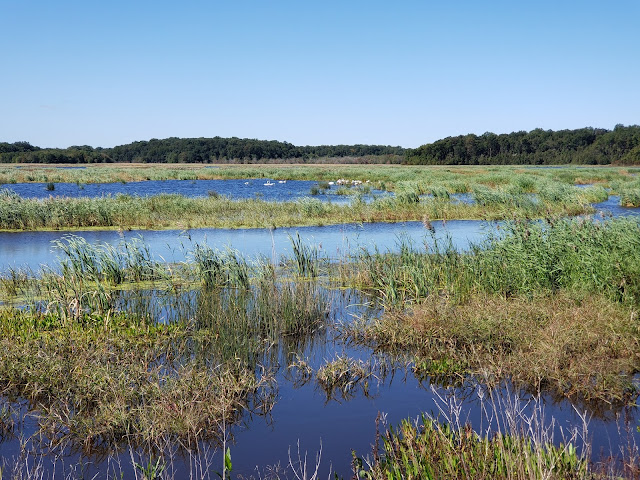Bombay Hook: One of the Best Birdwatching Sites in the Country
 |
| Tundra swans at Bombay Hook National Wildlife Refuge |
We spent the morning of the last day of summer exploring Bombay Hook Wildlife Refuge, created in 1937. It’s Delaware’s best-known birdwatching site, and Conde Nast Traveller has called it the most beautiful place in Delaware.
The highlight of Bombay Hook is a 12-mile driving tour, peppered with five short walking trails, three of them leading to wildlife observation towers. There are two excellent maps to guide your drive. The trail map highlights the locations of the five trails along the driving tour. The auto tour map highlights points of interest along the road.
The first stop on the driving tour is the Raymond Tower Trail. The trail goes through woodland to a viewing tower over Raymond Pool.
 |
| Raymond Pool at Bombay Hook National Wildlife Refuge |
The next stop is the boardwalk trail. There’s no parking lot here, so you’ll need to park along the narrow shoulders. There are some numbered stops along the trail, and you can download a guide with interpretive information on them. The trail first goes through woodland, past views of a brackish pond.
 |
| View from Bombay Hook's boardwalk trail |
Then the trail becomes a boardwalk running along Raymond Gut, a creek that leads to the Leipsic River, with the salt marsh beyond.

Lexie checking out Raymond Gut at Bombay Hook
The next place to pause on the driving tour is the stretch of road with Shearness Pool on the left and salt marsh on the right. There are some parking spaces and also broad shoulders for parking. We thought this was one of the most beautiful areas of Bombay Hook.
 |
| Shearness Pool in Bombay Hook |
Here’s where we saw birds in earnest, including a flock of tundra swans.
 |
| Two tundra swans on Shearness Pool |
We also saw egrets here and there, including this one in the salt marsh.
 |
| Egret in Bombay Hook salt marsh |
The Bear Swamp trail was perhaps our favorite trail—just a very peaceful walk through woodland to a tower overlooking Bear Swamp Pool. There are some numbered stops along the trail, and you can download a guide with interpretive information on them.
 |
| The woodlands around Bear Swamp Trail in Bombay Hook |
Our last stop was the Shearness Tower Trail. From the tower we saw a stunning view of Shearness Pond, the salt marsh beyond…and another egret!
 |
| Bombay Hook's Shearness Pool from the Shearness Trail Tower |
We enjoyed our visit to Bombay Hook, and we want to return during bird migration season and also to see the historic Allee House and walk the Parsons Point trail. But we thought our visits to other wildlife refuges along the Delaware Bayshore Byway have been more relaxing. Here one of the key attraction is birds, so you’re on constant alert, scanning the land, water, and trees for them.
As you enter or leave Bombay Hook, you’re driving through Raymond Neck National Historic District, a collection of three brick houses and some outbuildings all owned by wealthy and influential landowners in the mid-1800s. They are all on private property, and the only one we could see from the road is John Raymond House, built around 1830. Raymond was a slaveholder, and this house may have been built by slaves.
 |
| John Raymond House in Raymond Neck Historic District |
Bombay Hook is part of the National Park Service and charges an entry fee. Bombay Hook offers a lot of brochures to help you make the most of your visit, including wildlife and plant identification sheets. You can also take a virtual tour developed by the Friends of Bombay Hook. Bring a lot of patience; cars crawl slowly along the roads, and I’d expect that parking might be tight during bird migration seasons. If you visit close to sunset, you may see flocks of birds arriving to roost for the night. If you visit in summer, there are lots of mosquitos and horse flies, so bring plenty of bug spray or simply plan to stay in your car with the windows closed and air conditioning running.
There is a visitors center with restrooms, but it was closed during our visit because of the pandemic. Portapotties were placed nearby.



Comments
Post a Comment